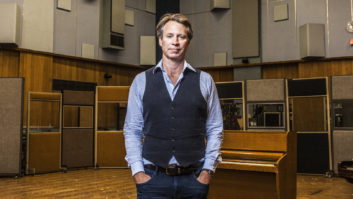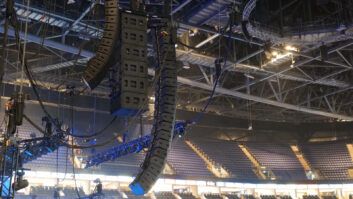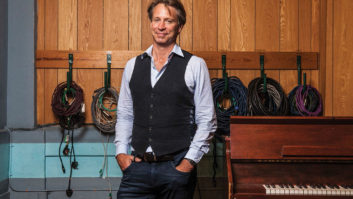The recent Killers U.S. tour presented a unique set of challenges for Delicate Productions.
Besides the need to provide consistent coverage in radically different venues ranging from mid-sized arenas to small theaters, casinos and ballrooms, the Camarillo, CA-based production company had to contend with cancellations of major arena shows at New York’s Madison Square Garden, Toronto’s Air Canada Centre and New Jersey’s Susquehanna Bank Center due to lead singer Brandon Flowers’ laryngitis.
That said, the tour was still well received by enthusiastic fans and media, earning praise from Rolling Stone magazine for its “thunderous, meaty sound” at the tour opener in Denver’s 1stBank Center.
The successful six-man band that formed in 2001 and consists of front man Flowers who also doubles on keyboards, Dave Keuning (guitars), Mark Stoermer (bass), and Ronnie Vannucci (drums), was supplemented by two multi-instrumentalists for this critical tour to support their popular Battle Born release.
Delicate actually picked up the tour from Capital Sound in the UK, making a seamless transition in terms of coverage, audio quality and impact. Asked if the systems were similar, Killers Front of House Engineer James Gebhard said, “Absolutely identical. Capital and Delicate worked really well hand in hand. We did some fine-tuning of the system in the UK and Capital communicated directly with Delicate about the details so they could be set up exactly the same. It was a very quick transition from one to the other.”
A veteran engineer who worked his way up from university amateur shows through a variety of bands to the highest level of touring, the Manchester-born Gebhard has been with the Killers since 2004. He had been using other line arrays before the tour, but Delicate was instrumental in getting him onboard with the Martin Audio MLA system.
As described by Delicate’s Smoother Smyth, the process involved several steps. “Once we had teamed with our friends at Capital for MLA,” Smoother recounts, “we got James to see the system in action in the UK and at a Zac Brown Band show in Indianapolis. We then brought him in to our warehouse to discuss MLA theory and spend some hands-on time with the system before he signed off on MLA for the tour. Needless to say, it worked out really well in the end for everyone involved.”
The touring setup included 14 MLA cabinets and two MLD down fill cabinets per side for the main PA; 12 MLA cabinets per side for the side hangs; 20 MLX subwoofers ground-stacked in a cardioid broadside array in front of the stage along with four MLX flown per side to fill in those areas. I10 Martin Audio W8LC cabinets along the stage edge are used for in fill.
In addition to MLA, Gebhard relied on his “ever-trusted” DiGiCo SD7 console with two 56-channel DiGiCo SD racks stage running at 96 kHz along with Waves SoundGrid processing and plug-ins. A variety of microphones were used, starting with a Shure SM58A for lead singer Flowers to a mixture of Shure, Audio-Technica, Sennheiser and E-V, depending on what worked best for the job.
Asked about his maiden voyage with MLA during this critical tour, James was typically candid, “Smoother had to go out of his way to convince me to switch to MLA, but once I was able to work on it, I was amazed.
“One of the most impressive aspects is the phase coherence,” he explains. “Walk the room and everywhere you go it sounds exactly the same. It’s like an audio guy’s dream. You don’t have to start making compromises or second-guessing yourself, searching for holes in the coverage between PA points or the back and front of the room. You can’t believe it actually does what is says it does.”
MLA’s scalability also proved to be very useful for this tour, especially given the radical differences in sizes from venue to venue. As Gebhard points out, “With typical line arrays, you work an artificial X amount of boxes per side to do an arena, but because of what MLA does with all the steering, you can use less boxes for the venue. It all depends on how you predict the room, what you want to do and what the software comes up with. Whether it’s smaller or larger room, you could almost use the same amount of boxes, which definitely makes MLA a very scalable system. And the sound was literally identical everywhere we went, every day. It was fantastic. The pure consistency regardless of the type or size of the room.”
Another useful aspect for Gebhard was MLA’s Hard Avoid feature. “We played around with it a lot during rehearsals in Vegas,” he recalls. “We were in a sound room with very reflective back walls and ceilings so we set it up in there, put on the hard avoids and it made the room sound incredible.
“As far as I’m concerned, Martin Audio has reinvented the wheel in terms of PA design with MLA,” he concludes. “It’s just unbelievable.” The biggest problem Martin Audio has is marketing the product. They really need to get the word out because it’s unbelievable.”
Unfortunately, Delicate was never able to fly the full MLA/MLA Compact system due to the cancellation of the major arena shows. Smoother points out that “it was disappointing that we didn’t get to rig the full system, especially hearing it with the MLA Compacts rigged for rear coverage. But we’ll be using it for the makeup dates in May.”
Pressed for his feelings about MLA, Smyth is enthusiastic but judicious in his response. “I don’t claim to know it all, which is why I surround myself with people who know audio, video and lighting in depth and give in to their wishes. We look at what’s out there in the marketplace, evaluate it and the purchases come on the merits of the product. My guys said ‘MLA is a must-have.’ And even though it’s a challenge because of the cost and complexity of the onboard technology. But at the end of the day that’s what separates MLA from all of the competitive products.
“In the end, I always want to be with the leading edge on anything and everything, and MLA truly is in a class of its own. It’s not just being operational at the flick of a switch; it’s a whole other mindset that represents a new learning curve for engineers that go out with this system. Which means hard work on our part in terms of training courses, the software and hardware updates. We’re dealing with a whole new audio concept, which is very different from anything we’ve worked with before.
“When I worked the MusicCares event with Paul McCartney last February, we deployed MLA and it sounded like a Vegas showroom. And no one thanked us for a job well done because it was just accepted that the room must sound that good. It gives us great satisfaction to provide engineers with such a great place to start from.
“Given the size of the MLA, what it puts out is remarkable and stunning,” Smyth concludes.” It’s a midsized box that can outperform all of the large format cabinets in the marketplace. The fact that I can use it in theaters, hotel ballrooms, casinos, arenas and up, speaks volumes.”
For more about Martin Audio, please click to www.martin-audio.com.
About Martin Audio®
Founded by audio engineer David Martin in 1971, Martin Audio pioneered the use of all-horn-loaded bass designs in world-class touring loudspeaker systems for groups such as Pink Floyd, ELP and Supertramp. Located outside of London, Martin Audio now embodies a sophisticated mix of acoustic design, research, mathematical modeling and software engineering for a wide range of products in the installation, cinema and touring sound markets.







